Yves here. John Helmer provides an important update on the aims and progress of Russia’s attacks on the electric grid. If you’ve been following the combat closely, you have probably already learned that Russia has changed from its strategy of fall-winter 2022, of targeting transmission, to targeting generation facilities. The former approach was intended to deplete Ukraine’s air defense missiles, as well as get an understanding of how the grid functioned.
Now Russia is moving systematically to deprive Ukraine of power. While big targets include key cities in the east, like Kharviv, as well as the high priority Odessa. But the attacks have now moved to striking facilities all across Ukraine.
Protracted blackouts, as Helmer points out, will result in pretty much all of the remaining civilian population to leave, allowing military operations to proceed with fewer constraints. Helmer also points out that the stopgap of moving the remaining supply around Ukraine both risks the grid itself, as well as user equipment. One would think critical devices would sit behind surge protectors. But theory and practice often differ, and surge protectors can degrade.
But on top of that, no or extremely erratic power will make Western fantasies impossible, not just weapons manufacture in Ukraine but even NATO operation, which depends on being able to charge or fuel many devices.
Helmer also notes the Russians have successfully struck fuel storage facilities. At least one, according to YouTubers, was believed to hold a not-trivial amount of European gas. Whose bright idea was it to keep it in a theater of conflict?
Also finally notice that Russia is reported to be close to implementing a reverse-surge drone which could potentially send reverse surges into European power suppliers, as in Poland, Romania, and Moldova. Ouch!
By John Helmer, the longest continuously serving foreign correspondent in Russia, and the only western journalist to direct his own bureau independent of single national or commercial ties. Helmer has also been a professor of political science, and an advisor to government heads in Greece, the United States, and Asia. He is the first and only member of a US presidential administration (Jimmy Carter) to establish himself in Russia. Originally published at Dances with Bears
The electric war, which in its first phase commenced in September 2022, has now entered its second and final phase – final, that is, for the Ukraine.
This is strategic; war has never been fought like this in Europe. The US and NATO general staffs and politicians have been taken by complete surprise. “The Ukrainians are building Maginot and Siegfried lines according to the instructions of their foreign advisers,” according to a Moscow analyst, “as if the Russian offensive will be men, artillery and tanks running across the landscape towards Kiev. But they won’t have to. The offensive against Ukrainian electricity cannot be stopped at these lines.”
Without effective defence for its power generating plants, distribution hubs, and grid lines, the Kiev regime’s power is being stopped across the country; the major Novorussian cities in the east – Odessa, Kharkov, Dniepropetrovsk – are being blacked out and their populations forced to evacuate; the warmaking resupplies of the NATO allies are being cut off at borders which are now exposed to reversal of electricity surges threatening the plants and grids of southern Poland, Romania and Moldova. Even European and American money for President Vladimir Zelensky’s regime needs electricity to move.
“The Russian General Staff is thinking electrically,” comments a NATO veteran and expert in applying electrical engineering to war. “The way the strikes are unfolding causes the Ukrainians to perform at lot of switching. Anyone who knows anything about high-voltage switching understands that the more it’s done, the greater the likelihood there is of some kind of fault occurring, including surges or transients, occurring. So, leaving enough power on today so the Ukrainians can throw switches tomorrow may be part of the plan.”
“Even if the French/NATO plan a deployment in the Ukraine, what will they be deploying to?” the military engineer adds. “If the current Russian plan of attack is causing swings of 300+ volts, it’s not even safe to plug in a cell phone. We can safely assume that all manner of appliances and other expensive electrical or electronic equipment has been destroyed in the affected areas. Indeed, even if the power engineers manage to get the power back on, millions of light fixtures, especially the electronic/LED variety, are burned out. Diagnostic equipment (medical and technical), process instruments, programmable logic controllers, power supplies, inverters, frequency drives, bank machines, computerized checkout, refrigeration equipment, are burned up”
“Who knows what’s happening there. It must be chaos, and if it isn’t, it will be soon.”
The Russian General Staff doesn’t telegraph its punches. The daily Ministry of Defense operations briefing – blocked for many US and allied audiences – concentrates on the five combat groups, Western, Southern, Eastern, Centre, and Dniepr; and their operational directions along the Donbass line of contact; at present, they are Kupyansk, Donetsk, Avdeyevka, South Donetsk, and Kherson.
Last Friday, for example, the briefing began almost nonchalantly: “Tonight [March 29], the Armed Forces of the Russian Federation launched a group strike with high-precision long-range air, sea and land-based weapons, including aeroballistic hypersonic Kinzhal missiles, as well as unmanned aerial vehicles, at energy facilities and air defence of the Armed Forces of Ukraine. The objectives of the strike have been achieved. All objects are affected.”
The next day, March 30, petroleum and fuel oil storages, which have been dispersed to shield them from attack and are necessary to power the emergency generators, were destroyed in the Poltava region. On Sunday, March 31, the targeting of gas storage and gas production around Lvov was also reported by the Defense Ministry in Moscow. “The Russian Aerospace Forces carried out a group strike with high-precision weapons on the facilities of energy infrastructure and the gas-producing industry of Ukraine. As a result of the strike, the work of the defense industry enterprises for the manufacture and repair of weapons, military equipment and ammunition was disrupted. All targets of the strike have been achieved. The objects are affected.”
The detailed targeting of the electric war campaign can be found in the Russian military bloggers who compile their reports and maps from a range of Russian and Ukrainian sources, including videoclips from residents in the targeted cities.
The westward extension of the missile and drone targeting has included Khmelnitsky, Rivne and Burshtyn, around the Galician capital of Lvov, in this map and summary from Militarist for March 29.
MAP OF RUSSIAN STRIKES AGAINST UKRAINE POWER PLANT TARGETS, MARCH 29
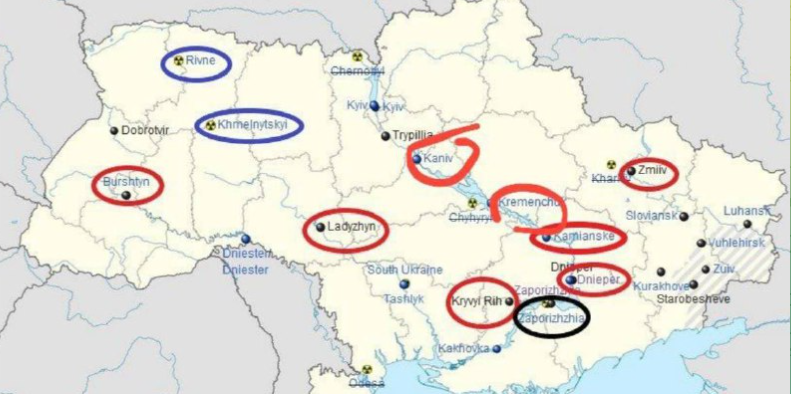
Source: https://t.me/infantmilitario/123071
“Ukraine is moving towards a truly definitive energy crisis”, Militarist reported on March 30. “In the east and west, thermal power plants are being eliminated one by one by completely demolishing the main turbine and generator sections. Dams also began to collapse from south to north. It is expected that all dams and thermal power plants will be put out of operation in the near future. The Ukrainian military industry will be destroyed both by direct attacks and by the energy crisis. The possibility of NATO-supported domestic production and maintenance will also be excluded. Thus, the logistics infrastructure in the rear may not be able to cope with events at the front.”
The Russian ordnance used is overwhelming; this is corroborated by Ukrainian reports. Tactically, drones are launched in swarms, the first wave to identify and activate the air defence missile and artillery systems around the electricity targets; in the second wave drones and missiles strike their targets. According to Ukrainian data, in just two days from March 22 to 24, 208 missiles and unmanned aerial vehicles (UAVs) were fired at the country’s energy facilities.
UKRAINE REGION MAP OF POWER PLANT TARGETS, OUTAGES CONFIRMED, MARCH 22-24
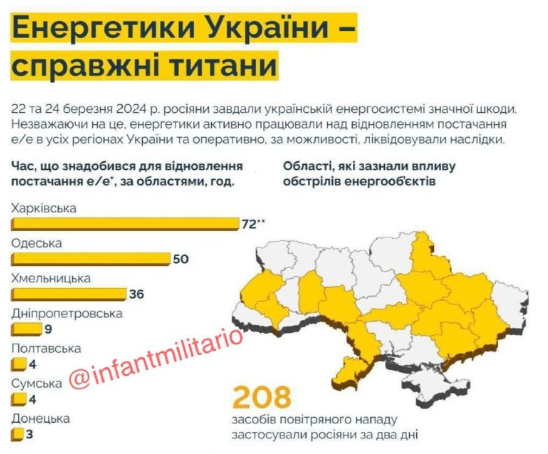
Source: https://t.me/infantmilitario/122995
The inadequacy of Ukrainian and NATO means of defence is explained by a Russian source, describing how the long-range, air-launched X-101 missile has been modified. “The warhead has almost doubled and now is not 450 kg, but 800 kg. For this, part of the fuel tank has had to be sacrificed. However, given the size of Ukraine and the range of the X-101, the missile will not lose its effectiveness against energy system targets, like the Dnieper Hydroelectric Station (HPP). Apparently, it was one of the first recipients.”
The tinkering, testing, and launching are a constant Russian process; there is nothing comparable on the US, French, or European side, although weaponizing electricity is not new. The Iraqi military did it against Iran in February 1984 when high-voltage power lines were dropped into Fish Lake, east of Basra, electrocuting Iranian soldiers attempting to cross the lake. The Russians have the capability to use drones to drop wires on overhead lines and allow them to settle on the ground near Ukrainian deployments, lines of fortifications, or the westward routes of retreat.
Also, Russian sources believe a new drone weapon is being designed for triggering reverse surges along the Ukrainian grid lines, completing the knockout of the domestic Ukrainian transmission grid, and surging back into the sources of replacement electricity from Poland, Romania, and Moldova.
UKRAINE MAP OF ELECTRICITY REPLACEMENT IMPORT SOURCES
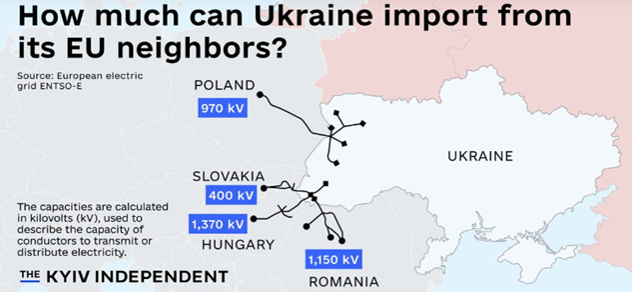
Total maximum power source capacity claimed from imports 3,890 kV. Source: https://kyivindependent.com
MAP OF UKRAINE HIGH-VOLTAGE TRANSMISSION LINE TARGETS FOR RUSSIAN DRONES
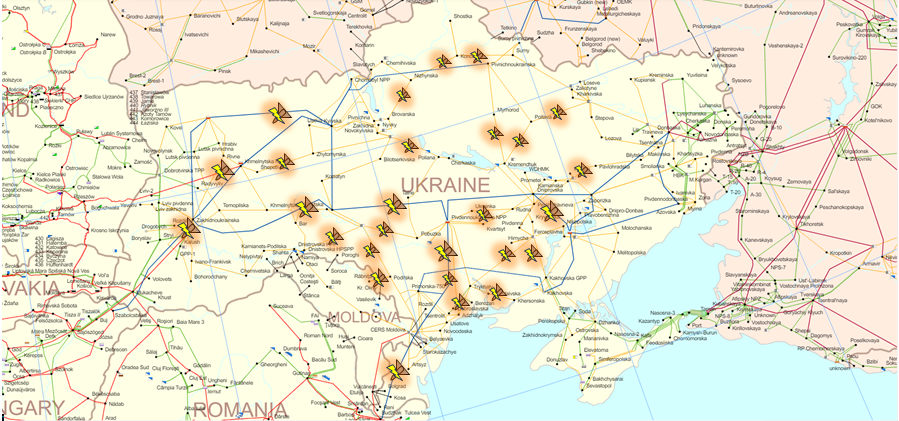
Click on image to enlarge. Key: blue=750kV transmission line; orange=330kV transmission line;red=750kv transmission line. From the south Moldova and Romania are sending power; to cut this off and threaten the cross-border source, the target is the 750kV line (yellow) just west of the Artsyz SS hub which connects northward to the Pivdennoukrainska NPP. The Polish line (in red) is vulnerable to a strike west of Rivne. The lines to and from Hungary and Slovakia can be targeted south of the Zapadnoukrainska SS. The Slovak and Hungarian sources are unlikely to be targeted, the Ukrainian grid distributing their power more likely. The drone for targeting these elements is designed as an explosive inductor, dropped on and connected to the high-tension lines to produce voltage surges and dips, so that when the Ukrainian utility engineers try to rig repairs, close the breakers or switches, the drone-producing surges will blow the circuits up and down the transmission lines.
Boris Rozhin, who publishes the Colonel Cassad military blog, has tabulated the destruction of the generating units east and west of Kiev as of March 30.
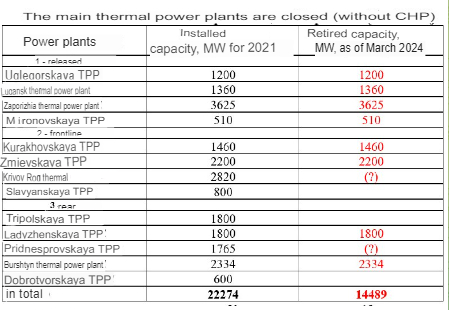
Source: https://t.me/boris_rozhin/118499
“Updated data on the state of thermal power plants in Ukraine. In 2021, Ukraine controlled 13 thermal power plants (formerly GRES) with a total installed capacity of approximately 22.3 GW. During the fighting, 4 thermal power plants with a total installed capacity of approximately 6.7 GW came under the control of the Russian Federation. The damaged Kurakhovskaya TPP in the frontline zone – 1.4 GW - has been completely stopped. A representative of DTEK said that on March 22, 2024, the Burshtyn and Ladyzhinskaya TPPs were completely destroyed – 2.3 and 1.8 GW, respectively, and Centrenergo reported the complete destruction of the Zmievskaya TPP – another 2.2 GW. Thus, Ukraine has lost at least 14.5 GW of the thermal power plants that operated in 2021. At the moment, the extent of damage is unclear to at least two more thermal power plants which have come under attack – Pridneprovskaya and Krivoy Rog. Accordingly, 9 thermal power plants remaining under Ukrainian control, include 4 destroyed, 2 at least damaged, and 3 thermal power plants that are probably unaffected. The total installed capacity of 5 ‘conditionally alive’ is about 7.8 GW, but most likely much less, taking into account strikes at the Pridneprovskaya and Krivoy Rog thermal power plants.”
What is left of Ukraine’s energy system at the moment, and what can survive if the intensity of the Russian campaign is sustained for several more weeks?
According to Rozhin, as of Sunday night, “most of Ukraine depends on four main energy sources: South Ukrainian NPP, Kyiv power plant, Vinnitsa 750 kV and Moldovan transit. The total generation is about 8 GW, but even this does not supply all the need for energy, so now the weather is of great importance for the enemy for the production of alternative energy (solar, wind).”
“The sweetest targets”, Readovka.ru reported on March 30, “are the high-voltage substations of 750/330 kV, as well as the border substations through which the energy transfer from the EU goes. First of all, we are talking about the Zapadnoukrainskaya substation in the Lvov region.”
“There are a total of 141 transmission substations in the Ukraine,” the western military engineer source notes. “It’s not at all outside of the Russian capacity to destroy them. Nor is it outside of their capacity to destroy the transmission towers, short-circuit the lines, screw up the synchronization equipment, and so on.”
The Ukrainian media and press releases from the DTEK utility confirm the vulnerability, especially as the country approaches the June-July period of maximum summer power consumption. Rolling blackouts are being imposed, then lifted, then reimposed, according to the announcements to domestic consumers. This means that the utilities and repair engineers are finding it increasingly difficult to keep up with the pace of the attacks.
In Kharkov, for example, the current rolling blackouts of four hours or more mean that food will be spoiling in refrigerators, telephones will be dead, the internet will be down, and services will seize up. Once the liquid fuel stocks dwindle – these are also under parallel attack – the emergency generators will stop running, such food as there is will rot in the grocery stores.
This is a type of siege by electricity. The Kiev regime will be unable to reinforce or resupply the eastern cities, and there will be no Russian ground advance; no Mariupol, Bakhmut or Avdeyevka battles; no electricity until capitulation.
The military sources on whom the milbloggers rely also warn: “Yes, the damage is more than serious,” according to Rozhin, “but you should not accept on faith all the statements of the enemy about the damage received, since it is beneficial for him to overestimate the damage and foster the impression on our side that the work has been done and so we will not finish off those targets which have already received serious damage, but can be restored.”
The electric war is an operation to bypass the cities which the Ukrainians and their US and NATO military staffs believe will soon be targets for direct Russian attack. The lines of fortification look like this:
FORTIFICATION LINES CONSTRUCTED FOR KIEV, DNIEPROPETROVSK

Source: https://t.me/boris_rozhin/118484
A western military source believes, like Russian sources, that the Russian General Staff will make no direct city attacks and will leapfrog over or bypass the new fortifications. Where they have been built to the east of Dniepropetrovsk and to the north of Kiev and Chernigov, the source suspects, “the Ukrainians have created a Siegfried Line which the Russians will use against them later. Some of the fortifications face the wrong way, but the dragons’ teeth, wire and ditches will work fine in reverse when the time comes to enforce the DMZ.” For more on how the demilitarized zone will be drawn, read this.
NATO intelligence reports, leaked apparently by the French in support of President Emmanuel Macron’s hints of fresh deployments of French, Polish, and Baltic forces at the new fortified lines, are dismissed by sources in Moscow; they warn that the French, like the Americans in Kiev and Brussels, lack the intelligence to distinguish between force and feint.
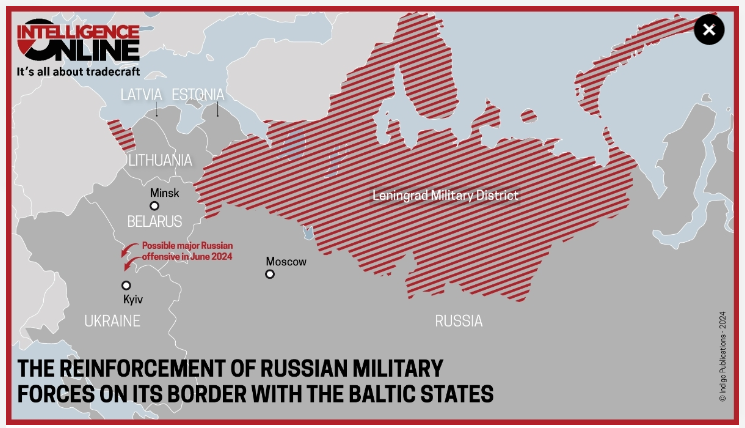
Note the French arrows of “possible major Russian offensive in June 2024”. Source: https://www.intelligenceonline.com/ Intelligence Online is published in Paris by a group which claims “we are not culturally partisan, either toward France's interests nor those of the third world.... We are very careful not to have any 'national' positioning’ ”.
A western military observer agrees. “My read is that the General Staff are deploying to tie down NATO and Ukrainian forces west of the Dnieper; assembling a credible force to dissuade any NATO move to threaten Kaliningrad; ensuring Belarussian territory is secure from the kind of raids we’ve seen in the Belgorod region.” They are also signaling what the Americans and French can’t admit in public that NATO forces are so weak in terms of manpower, equipment, ammunition, airpower, and capacity to engage that the Russian and Belarussian forces have the capacity to choose and dominate the field on a full spectrum basis whenever they choose.”
“The strategy”, the western military source again, “is to draw more of the NATO forces into the zones which are rapidly becoming de-electrified where they will soon be cut off from resupply or escape. The loss of electricity in Kharkov is already pitting the Ukrainian and foreign staff bunkers and troops in position against the city’s citizens for access to power, light, everything. It’s becoming an ungovernable situation. That’s the strategy.”
“The unspoken Russian advice is for the French, Poles, etc., to stick to posturing and grandstanding unless they have large reserves of body bags and candles laid up.”
NOTE: The lead image shows a night strike by drones in the Odessa region on March 30-31. According to Rozhin’s report, “the Russian forces attacked energy infrastructure facilities in the Odessa region. Coordinates: 46.6995149, 30.9316853. During the raid, the Ajalyk 330 PS northeast of Odessa was put out of action. After the strike, most of Odessa and nearby settlements were left without electricity. There was a powerful fire on the territory of the facility, which is also confirmed by satellite thermal indicators. The damage inflicted does not allow transferring power to the city from the South Ukrainian NPP in the Nikolaev region. Coordinates: 46.4538478, 30.3870876. Another blow was struck at one of the two autotransformers of the Novoodesskaya 330 kV substation… As a result of the strikes, the situation with Odessa's electricity supply has approached critical: there is no local generation, and power from the South Ukrainian NPP simply does not reach the city.”


